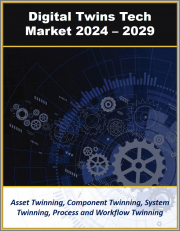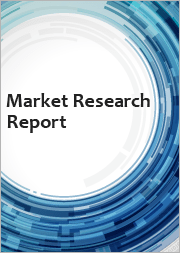
|
시장보고서
상품코드
1498820
디지털 트윈 시장 : 기술, 트위닝 유형, 사이버 투 피지컬 솔루션, 사용 사례, 산업·용도(2024-2029년)Digital Twins Market by Technology, Twinning Type, Cyber-to-Physical Solutions, Use Cases and Applications in Industry Verticals 2024 - 2029 |
||||||
세계의 디지털 트윈 시장을 조사했으며, 디지털 트윈 기술, 솔루션, 사용 사례, R&D, 초기 도입에서 주요 기업 노력의 평가, 용도 개발·운영을 포함한 디지털 트윈의 제품과 서비스 에코시스템의 평가, 산업별 사용 사례의 고려를 정리하여 전해드립니다. 또한 디지털 트윈을 지원하고, 디지털 트윈의 혜택을 받는 기술에 대해서도 분석 하고 있습니다. 또한 제조 시뮬레이션 및 예측 분석 등 많은 부문과 사용 사례에서 디지털 트위닝 솔루션에 대해 2024-2029년의 상세 예측을 세계, 지역, 주요 국가의 예측과 함께 제공합니다.
주요 리포트 결과
- IT 의사결정자의 47%가 디지털 트윈을 모른다.
- 스마트 시티에서 디지털 트윈 솔루션은 2029년에는 59억 달러 규모에 달한다.
- IoT 플랫폼의 95% 이상에서 2029년에는 어떤 형태로든 디지털 트윈 기능이 탑재된다.
- 디지털 트윈은 IoT 애플리케이션 이네이블먼트의 표준 기능/특징이 된다.
- 주요 디지털 트윈 솔루션에는 자산 트위닝, 컴포넌트 트위닝, 시스템 트위닝, 프로세스 트위닝, 워크플로우 트위닝이 포함된다.
- 벤더의 96.5%가 산업용 디지털 트윈 기능을 갖춘 IIoT API와 플랫폼 통합의 필요성을 인식하고 있다.
- 폭넓은 업종의 경영 임원의 47.2%가 디지털 트윈의 이점을 이해하고 있으며, 그 중 63%는 2029년까지 자사 업무에 도입하는 것을 계획하고 있다.
산업별 디지털 트윈 기술 :
디지털 트윈 기술은 물리적인 자산 및 시스템, 프로세스 가상 레플리카를 작성할 수 있으므로 다양한 업계에서 채택이 진행되고 있습니다. 아래에 디지털 트윈을 활용하고 있는 주요 산업별 사례를 소개합니다.
제조
- 예지보전 : 고장을 예측하고, 정비 스케줄을 세우기 위한 기기 모니터링
- 프로세스 최적화 : 제조 프로세스의 합리화와 효율화
- 제품수명주기관리 : 설계로부터 제조 종료까지의 제품 추적
의료
- 환자 모니터링 : 환자의 디지털 레플리카를 작성하고 맞춤형 치료를 실현
- 의료기기 관리 : 의료기기의 시뮬레이션과 성능의 최적화
- 병원 관리 : 병원 운영과 환자 플로우의 강화
자동차·운송
- 차량 설계·시험 : 새로운 차량 설계 시뮬레이션과 성능 시험
- 플릿 관리 : 차량 플릿의 퍼포먼스 모니터링과 최적화
- 스마트 인프라 : 더 나은 교통 관리를 위한 스마트 시티 인프라와 차량의 통합
에너지·유틸리티
- 전력망 관리 : 배전 네트워크의 모니터링과 최적화
- 자산관리 : 풍력 터빈 및 태양전지판 등 에너지 자산의 추적과 관리
- 예지보전 : 중요 인프라의 고장 방지
항공우주·방위
- 항공기 설계와 정비 : 항공기의 성능을 시뮬레이션하고, 정비의 필요성을 예측
- 미션 플래닝 : 방위 작전과 미션 계획의 최적화
- 훈련 시뮬레이션 : 대원에게 현실적인 훈련 환경을 제공
부동산·건설
- 빌딩 인포메이션 모델링 : 건물의 상세 디지털 표시 작성
- 건설 프로젝트 관리 : 건설 프로세스의 모니터링과 최적화
- 시설 관리 : 건물의 관리와 운영의 강화
소매·소비재
- 공급망 최적화 : 공급망의 효율성과 대응력의 강화
- 고객 경험 : 소비자 행동의 디지털 레플리카에 기반한 고객 경험 퍼스널라이즈
- 재고 관리 : 재고 추적과 관리의 개선
스마트 시티
- 도시계획 : 도시 인프라와 서비스의 시뮬레이션과 최적화
- 공공 안전 : 긴급 대응과 치안 대책의 강화
- 지속가능성 : 환경에 대한 영향과 에너지 사용량의 모니터링과 관리
통신
- 네트워크 최적화 : 퍼포먼스 향상을 위한 통신 네트워크의 모니터링과 최적화
- 서비스 관리 : 통신 서비스와 고객경험의 관리 강화
- 인프라 관리 : 통신 인프라의 추적과 정비
목차
제1장 주요 요약
제2장 서론
- 개요
- 관련 기술과 디지털 트윈에 대한 영향
- 산업용 인터넷과 인더스트리 4.0
- 페어링 기술
- 사이버물리 시스템
- AR·VR·MR
- AI와 기계학습
- 적층 가공·3D 프린팅
- 잠재적 용도와 결과 분석
- MRO(정비·수리·점검)
- 소비자 자산의 디지털 아바타
- 퍼포먼스/서비스 모니터링
- 검사·수리
- 예지보전
- 제품 설계·개발
- 복합재 조립·제조
- 잠재적 사업 성과
- 디지털 트윈 서비스 에코시스템
- IIoT
- 소비자용 IoT
- 산업 발전
- Digital Twinning as a Service
제3장 디지털 트윈 기업의 평가
- ABB
- Allerin Tech Pvt. Ltd.
- Altair Engineering, Inc.
- Amazon Web Services
- ANSYS
- Aucotec AG
- Autodesk Inc.
- Bentley Systems, Incorporated
- CADFEM GmbH
- Cisco Systems
- Cityzenith
- Cosmo Tech
- Dassault Systems
- Digital Twin Consortium
- Digital Twin Technologies
- DNV GL
- DXC Technology
- Eclipse Foundation
- Emerson
- Emesent
- Faststream Technologies
- FEINGUSS BLANK GmbH
- Flowserve
- Forward Networks
- General Electric
- Hitachi Ltd.
- Honeywell
- HP
- IBM
- Industrial Internet Consortium
- Intellias
- Invicara
- KBMax
- Lanner Electronics
- Microsoft
- National Instruments
- NavVis
- Oracle
- PETRA Data Science
- Physical Web
- Pratiti Technologies
- Prodea System Inc.
- PTC
- QiO Technologies
- Robert Bosch
- SAP
- Schneider
- SenSat
- Siemens
- Sight Machine Inc.
- Simplifa GmbH
- Softweb Solutions Inc.
- Sogeti Group
- SWIM.AI
- Synavision
- Sysmex Corporation
- TIBCO Software
- Toshiba Corporation
- UrsaLeo
- Virtalis Limited
- Visualiz
- Wipro Limited
- XenonStack
- Zest Labs
제4장 디지털 트윈 시장 분석·예측
- 세계의 디지털 트윈 시장의 추이·예측
- 디지털 트윈 시장 : 트위닝 유형별
- 디지털 트윈의 용도
- 디지털 트윈 시장 : 산업별
- 제조 : 유형별
- 스마트 시티 : 유형별
- 자동차 : 유형별
- 의료 : 유형별
- 운송 : 유형별
- 디지털 트윈 시장 : 지역별
- 북미
- 남미
- 유럽
- 아시아태평양
- 중동 및 아프리카
제5장 결론·제안
KSA 24.06.28Overview:
This report evaluates digital twinning technology, solutions, use cases, and leading company efforts in terms of R&D and early deployments. The report assesses the digital twin product and service ecosystem including application development and operations. This includes consideration of use cases by industry vertical.
The report also analyzes technologies supporting and benefiting from digital twinning. The report also provides detailed forecasts covering digital twinning solutions in many market segments and use cases including manufacturing simulations, predictive analytics, and more from 2024 to 2029 with global, regional, and major country forecasts.
Select Report Findings:
- We found 47% of IT decision makers have never heard of digital twins
- Digital twin supported solutions in smart cities will reach $5.9 billion by 2029
- Over 95% of all IoT Platforms will contain some form of digital twinning capability by 2029
- Digital twinning will become standard feature/functionality for IoT Application Enablement by 2028
- Leading digital twin solutions involve Asset Twinning, Component Twinning, System Twinning, Process and Workflow Twinning
- 96.5% of vendors recognize the need for IIoT APIs and platform integration with digital twinning functionality for industrial verticals
- 47.2% of executives across a broad spectrum of industry verticals understand the benefits of digital twinning and 63% of them plan to incorporate within their operations by 2029
A digital twin is a virtual object representation of a real-world item in which the virtual is mapped to physical things in the real world such as equipment, robots, or virtually any connected business asset. This mapping in the digital world is facilitated by IoT platforms and software that is leveraged to create a digital representation of the physical asset.
The digital twin of a physical asset can provide data about its status such as its physical state and disposition. Conversely, a digital object may be used to manipulate and control a real-world asset by way of teleoperation. The publisher of this report sees this form of cyber-physical connectivity, signaling, and control as a key capability to realize the vision for Industry 4.0 to fully digitize production, servitization, and the `as a service` model for products.
There are many potential use cases for digital twinning including monitoring, simulation, and remote control of physical assets with virtual objects. Solutions focus on Part, Product, Process, and System twinning. Leading digital twin solutions involve Asset Twinning, Component Twinning, System Twinning, Process and Workflow Twinning. We see digital twinning playing a key role in many related IoT operations processes including IoT application development, testing, and control.
The implementation of digital twins will also enable distributed remote control of assets, which will place an increasingly heavy burden on IoT Identity management, authentication, and authorization. IoT authentication market solutions are also important in support of the "things" involved in IoT, which vary from devices used to detect, actuate, signal, engage, and more. This will become particularly important with respect to digital twin solution integration.
As reflected by the Digital Twin Consortium, we see some of the key industries to lead cyber-to-physical integration and solutions include aerospace, healthcare, manufacturing, military, natural resources, and public safety sectors. In terms of integrating digital twin technology and solutions with telecommunications and enterprise infrastructure, we see a need for careful planning from a systems integration, testing, and implementation perspective. This will be especially important in the case of mission-critical applications.
Digital Twins Technology in Industry Verticals
The technology is being increasingly adopted across a variety of industry verticals due to its ability to create virtual replicas of physical assets, systems, or processes. Here are some key industry verticals leveraging digital twins:
Manufacturing:
- Predictive Maintenance: Monitoring equipment to predict failures and schedule maintenance
- Process Optimization: Streamlining production processes and improving efficiency
- Product Lifecycle Management: Tracking products from design to end-of-life
Healthcare:
- Patient Monitoring: Creating digital replicas of patients for personalized treatment
- Medical Device Management: Simulating and optimizing the performance of medical devices
- Hospital Management: Enhancing hospital operations and patient flow
Automotive and Transportation:
- Vehicle Design and Testing: Simulating new vehicle designs and testing performance
- Fleet Management: Monitoring and optimizing the performance of vehicle fleets
- Smart Infrastructure: Integrating vehicles with smart city infrastructure for better traffic management
Energy and Utilities:
- Power Grid Management: Monitoring and optimizing power distribution networks
- Asset Management: Tracking and managing energy assets such as wind turbines and solar panels
- Predictive Maintenance: Preventing failures in critical infrastructure
Aerospace and Defense:
- Aircraft Design and Maintenance: Simulating aircraft performance and predicting maintenance needs
- Mission Planning: Optimizing defense operations and mission planning
- Training Simulations: Providing realistic training environments for personnel
Real Estate and Construction:
- Building Information Modeling: Creating detailed digital representations of buildings
- Construction Project Management: Monitoring and optimizing construction processes
- Facility Management: Enhancing the management and operation of buildings
Retail and Consumer Goods:
- Supply Chain Optimization: Enhancing supply chain efficiency and responsiveness
- Customer Experience: Personalizing customer experiences based on digital replicas of consumer behavior
- Inventory Management: Improving inventory tracking and management
Smart Cities:
- Urban Planning: Simulating and optimizing city infrastructure and services
- Public Safety: Enhancing emergency response and public safety measures
- Sustainability: Monitoring and managing environmental impact and energy usage
Telecommunications:
- Network Optimization: Monitoring and optimizing telecom networks for better performance
- Service Management: Enhancing the management of telecom services and customer experience
- Infrastructure Management: Tracking and maintaining telecom infrastructure
These are just a few examples, and the applications of digital twins are continuously expanding as technology advances and more industries recognize the potential benefits.
Companies in Report:
|
|
Table of Contents
1.0. Executive Summary
2.0. Introduction
- 2.1. Overview
- 2.1.1. Understanding Digital Twinning
- 2.1.2. Cognitive Digital Twining
- 2.1.3. Digital Thread
- 2.1.4. Convergence of Sensors and Simulations
- 2.1.5. IoT APIs
- 2.1.6. Software Modules and Elements
- 2.1.7. Types of Digital Twinning
- 2.1.8. Digital Twinning Work Processes
- 2.1.9. Role and Importance of Digital Twinning
- 2.2. Related Technologies and Impact on Digital Twinning
- 2.2.1. Industrial Internet and Industry 4.0
- 2.2.2. Pairing Technology
- 2.2.3. Cyber-to-Physical Systems
- 2.2.4. AR, VR, and Mixed Reality
- 2.2.5. Artificial Intelligence and Machine Learning
- 2.2.6. Additive Manufacturing and 3D Printing
- 2.3. Potential Application and Outcome Analysis
- 2.3.1. Maintenance, Repair and Overhaul Operation
- 2.3.2. Digital Avatar of Consumer Assets
- 2.3.3. Performance/Service Monitoring
- 2.3.4. Inspection and Repairs
- 2.3.5. Predictive Maintenance
- 2.3.6. Product Design & Development
- 2.3.7. Composite Assembling/Manufacturing
- 2.3.8. Potential Business Outcomes
- 2.4. Digital Twinning Service Ecosystem
- 2.4.1. Industrial IoT
- 2.4.2. Consumer IoT
- 2.4.3. Industry Development
- 2.4.4. Digital Twinning as a Service
3.0. Digital Twins Company Assessment
- 3.1. ABB
- 3.2. Allerin Tech Pvt. Ltd.
- 3.3. Altair Engineering, Inc.
- 3.4. Amazon Web Services
- 3.5. ANSYS
- 3.6. Aucotec AG
- 3.7. Autodesk Inc.
- 3.8. Bentley Systems, Incorporated
- 3.9. CADFEM GmbH
- 3.10. Cisco Systems
- 3.11. Cityzenith
- 3.12. Cosmo Tech
- 3.13. Dassault Systems
- 3.14. Digital Twin Consortium
- 3.15. Digital Twin Technologies
- 3.16. DNV GL
- 3.17. DXC Technology
- 3.18. Eclipse Foundation
- 3.19. Emerson
- 3.20. Emesent
- 3.21. Faststream Technologies
- 3.22. FEINGUSS BLANK GmbH
- 3.23. Flowserve
- 3.24. Forward Networks
- 3.25. General Electric
- 3.26. Google
- 3.27. Hitachi Ltd.
- 3.28. Honeywell
- 3.29. HP
- 3.30. IBM
- 3.31. Industrial Internet Consortium
- 3.32. Intellias
- 3.33. Invicara
- 3.34. KBMax
- 3.35. Lanner Electronics
- 3.36. Microsoft
- 3.37. National Instruments
- 3.38. NavVis
- 3.39. Oracle
- 3.40. PETRA Data Science
- 3.41. Physical Web
- 3.42. Pratiti Technologies
- 3.43. Prodea System Inc.
- 3.44. PTC
- 3.45. QiO Technologies
- 3.46. Robert Bosch
- 3.47. SAP
- 3.48. Schneider
- 3.49. SenSat
- 3.50. Siemens
- 3.51. Sight Machine Inc.
- 3.52. Simplifa GmbH
- 3.53. Softweb Solutions Inc.
- 3.54. Sogeti Group
- 3.55. SWIM.AI
- 3.56. Synavision
- 3.57. Sysmex Corporation
- 3.58. TIBCO Software
- 3.59. Toshiba Corporation
- 3.60. UrsaLeo
- 3.61. Virtalis Limited
- 3.62. Visualiz
- 3.63. Wipro Limited
- 3.64. XenonStack
- 3.65. Zest Labs
4.0. Digital Twins Market Analysis and Forecasts 2024 to 2029
- 4.1. Global Digital Twins 2024-2029
- 4.2. Digital Twins Market by Type of Twinning 2024-2029
- 4.3. Digital Twins Applications 2024-2029
- 4.4. Digital Twins by Industry 2024-2029
- 4.4.1. Digital Twins in Manufacturing by Type 2024-2029
- 4.4.2. Digital Twins in Smart City by Type 2024-2029
- 4.4.3. Digital Twins in Automotive by Type 2024-2029
- 4.4.4. Digital Twins in Healthcare by Type 2024-2029
- 4.4.5. Digital Twins in Transport by Type 2024-2029
- 4.5. Digital Twins by Region 2024-2029
- 4.5.1. North America Digital Twins 2024-2029
- 4.5.2. South America Digital Twins 2024-2029
- 4.5.3. Europe Digital Twins 2024-2029
- 4.5.4. APAC Digital Twins 2024-2029
- 4.5.5. MEA Digital Twins 2024-2029



















